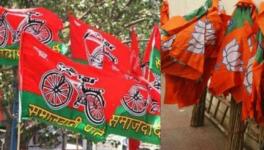UP Elections: Once Thriving, Kannauj’s Traditional ‘Itr’ Makers are Struggling to Survive
Kannauj/Delhi: Nothing stays longer in memory than a nice fragrance. This bears true to the city of Kannauj, one of the oldest hubs of producing perfume or itr, which bottles the aroma of rain on earth – along with other scents associated with various Indian traditions.
The look of dusty roads, placid bovines and zigzag traffic might appear uncomfortable to one, but a walk inside the ancient city, which is a six-hour drive from New Delhi, has a soothing effect on the soul with lingering scents of all sorts keep the air aromatic – thanks to the perfume industry along the lanes and bylanes of the district.
Located near the confluence of the Kali and Ganga rivers, Kannauj has been distilling ‘itr’ for centuries now with flowers, such as jasmine, rose, bela, etc. and herbs like kapoor kachri (spiked ginger lily), nagarmotha (nut grass), brahmi (waterhyssop), sugandhbala (Indian valerian), kachri (wild variety of cucumber), sugandh mantri (homalomena aromatica), cardamom, clove, camphor, etc.
The ‘itr’ made here is rich, without any dilution. Unlike alcohol-based perfumes, the fragrance is heavier but quieter, and lasts longer.
The history of ‘itr’ manufacturing in the district is traced to the reign of Harshavardhana, who belongs to the Vardhana dynasty and ruled North India between 606 and 647 AD. But the industry got a boost during the rule of the Mughals. There is a popular anecdote that Asmat Begum, the mother of Mughal queen Noor Jahan, first realised that oil can be extracted from rose petals after she spotted the flower leaving oily residue over warm bath water. Emperor Jehangir, too, is said to have written about his mother-in-law extracting rose attar.
The town still uses the traditional and largely eco-friendly methods of fragrance extraction from flower petals through steaming and distillation. No electricity or heavy machinery is used in this process. This is called the ‘degh bhapka’ method.
In this process, flower petals are boiled in large copper pots called ‘deghs’. During the boiling, the deghs are sealed with clay to ensure the fragrant vapour does not go waste in the air. The fumes are made to pass through a funnel, which is called ‘chonga’, and enter another container called ‘bhapka’. The bhapka contains water and base or essential oil made of sandal, liquid dioctyl phthalate (DOP — a solvent chemical). The water helps the vapour get condensed inside the dhapka. The base or essential oil, which has no odour of its own, holds the fragrance by absorbing the condensing liquid.
To give the mixture a different fragrance, it is mixed with kesar (saffron), musk, oud, camphor etc, accordingly.
Notably, the temperature has a very important role to play here. If the ‘degh’ is too hot, the fragrance of delicate petals gets destroyed. And if the ‘bhapka’ is not cool enough, the fumes will not condense in time. There is no fixed formula to ensure all this, and workers rely on the knowledge they have inherited from their forefathers.
There are two types of the condensed vapour — rooh and kyora oil or kyora sandali. For extraction of the former, no base oil is used. Flower petals are put in the ‘degh’ and tap water is poured in a certain quantity. It is boiled and the vapour is collected, following the same process. With steam, the flower petals secret oil which is collected in the ‘dhapka’. This oil is called ‘rooh’, which is the purest form of ‘itr’ and is very costly, as five quintals of flower petals secrete only 10-15 gram of ‘rooh’.
Later, the ‘rooh’ is diluted with base oil keeping in mind the prices offered.
Kannauj city is unique for bottling ‘mitti ka itr’ (the scent of soil) — a pleasant smell that frequently accompanies the first rain after a long period of warm and dry weather.
A manufacturer, requesting anonymity because of large-scale raids being conducted by the Enforcement Directorate and the Income Tax Department, said Kannuaj’s ‘itr’ does not used alcohol. It makes the scent inger longer.
When asked why the traditional methods are used even in this era of cutting edge technology, he said the purity of product would be compromised with modernisation of the industry. For example, he said, if copper was replaced with some other substitute, there was a possibility of the petals sticking to the surface of the vessel, and that may kill the fragrance with the smell of burning.
Similarly, iron will rust and interfere with the fragrance. “Our perfume-making is a precise art which requires human intelligence. It can’t be totally mechanised,” he added.
The delicate process of extraction is in tune with the cycle of seasons, the weather and the soil. ‘Shamama’ (a blend of warm spices and herbs) and ‘khus’ (vetiver) are produced in winters. Summer is for ‘mitti ka itr’ because the soil is dry in this season. Only desi (locally grown) pink roses are used here because it is the very fragrant. Jasmine can only be picked at night. The time difference between the plucking of flowers and the extraction of fragrance can impact the quality of ‘itr’.
STRUGGLE TO RETAIN TRADITION, GLORY
The Kannauj ‘itr’ industry is estimated worth over Rs 1,200 crore. Around 80% of the district’s population is directly or indirectly involved in the industry. However, the industry is facing several challenges, the main one being its dependence on natural ingredients.
“There is 18% GST (goods and services tax) on the base oil. The trade of sandalwood is also heavily regulated. With the unprecedented hike in diesel prices, the cost of other raw materials, such as DOP, HLP, DEP, etc. have grown two-fold, but the prices of the final product is almost same, as it is already too high and cannot be increased further. Around 5 grams of ‘rooh’ is extracted from 40 kg of roses and it sells for around Rs 9 lakh per kg. It takes 80 kg of vetiver to produce 50gm ‘rooh’. Musk or ‘kastoori’ is extracted from the navel of the musk deer, whose hunting is banned. We buy ‘kastoori’ at government auctions, where it sells for Rs 42 lakh per kg,” said the manufacturers.
‘Itr’ is now facing strong competition from the much cheaper synthetic perfumes. Therefore, the manufacturers are now shifting to the aromatherapy industry that produces essential oils, shampoo and soaps. The gutkha/paan masala industry has emerged as the major consumer of Kannauj’s ‘itr’ industry. They manufacture the scents synthetically, but still look for natural products for flavour and texture.
This emphasis on raw materials is also a reason why the industry has not taken to e-commerce platforms in a big way. “On mass e-platforms like Amazon, there is no screening for quality. Our products have to compete with synthetic substitutes of similar names, obviously selling at far lower prices,” they said.
The government has rolled out several schemes to boost the industry, but “not much are seen on the ground.”
One such scheme is ODOP (one district, one product). This was started with the view to making small-scale industry workers 'atmanirbhar' (self-reliant). It was tasked with assisting medium, small and micro enterprises in selling their products online on a larger scale. But the scheme does not seem to be reaching the actual beneficiaries.
Majority of ’itr’ manufacturers as well as traders this correspondent spoke to said the scheme has "largely failed to achieve its objective of empowering small industries".
Get the latest reports & analysis with people's perspective on Protests, movements & deep analytical videos, discussions of the current affairs in your Telegram app. Subscribe to NewsClick's Telegram channel & get Real-Time updates on stories, as they get published on our website.
























